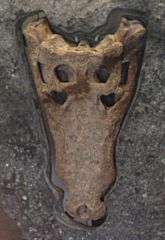Project 5085: I. Arribas, A. D. Buscalioni, R. Royo Torres, E. Espilez, L. Mampel, L. Alcalá. 2019. A new goniopholidid crocodyliform,Hulkepholis rorisp. nov. from the Camarillas Formation (early Barremian) in Galve, Spain). PeerJ. 7:e7911.
Abstract
BackgroundThe neosuchian crocodyliform genus Hulkepholis constitutes the longirostral lineage of the European Goniopholididae. It comprises two species ranging from the Valanginian of southern England to the lower Albian of the northern Teruel (Spain). A new species of Hulkepholis is described based on a partially complete skull from the lower Barremian Camarillas Formation. We investigate its phylogenetic position and the palatal patterns among members of Goniopholididae and the closely related Thalattosuchia and Tethysuchia.MethodsPhylogenetic relationships were investigated with two matrices using a previously published dataset as the basis: the first differed only by the addition of the new species, the second had newly discovered states for 11 characters, the new species plus several additional specimens of Hulkepholis and Anteophthalmosuchus. Both matrices were processed using TNT v. 1.1, in a heuristic analysis of maximum parsimony, with tree bisection and reconnection 1,000 random addition replicates and saving the 10 most parsimonious trees per replicate, and up to 10 suboptimal trees to calculate Bremer supports. The skull geometry of nine species from Thalattosuchia, Tethysuchia and Goniopholididae was explored to test shape variation between the rostral and postrostral modules, and to visualize the differences on the secondary palate. A set of 18 landmarks was used to delimit significant anatomical features, and the skulls were isotropically scaled using Adobe Illustrator, with the longest skull (Sarcosuchus imperator) as the baseline for comparison.ResultsThe European lineages of goniopholidids are two clades (Nannosuchus + Goniopholis) plus (Hulkepholis + Anteophthalmosuchus). The new species, Hulkepholis rori sp. nov, shares with the latter clade the following apormorphies: a long anterolateral postorbital process, postorbital process almost reaching the anterior jugal ramus, and basioccipital tubera with lateral edges turned posteriorly. Anteophthalmosuchus was found to be monophyletic, and Hulkepholis paraphyletic due to the poor preservation of H. willetti. Hulkepholis rori is distinguished by having vascular fossae and a mid-protuberance on the ventral surface of the basioccipital, and wide internal fossae in the quadrate. Among Goniopholididae differences on the secondary palate are the presence of a palatal cleft, the narrowness of the secondary choana, and a wide foramen of the median pharyngeal tube.ConclusionsThe new species is the earliest Hulkepholis from the Iberian Peninsula. New characters have been recognized in the organization of the palate and in the occipital region raising unexpected questions on the evolution of Goniopholididae. The set of palatal characters is discussed as part of a singular palatogenesis in Goniopholididae. The protruding occipital areas suggest that the longirostral Hulkepholis would have had an aquatic lifestyle with particular neck and skull movements.Read the article »
Article DOI: 10.7717/peerj.7911
Project DOI: 10.7934/P5085, http://dx.doi.org/10.7934/P5085
| This project contains |
|---|
Download Project SDD File |
Currently Viewing:
MorphoBank Project 5085
MorphoBank Project 5085
- Creation Date:
05 February 2024 - Publication Date:
05 February 2024
Authors' Institutions ![]()
- Universidad Autonoma de Madrid
- Fundación Conjunto Paleontológico de Teruel‐Dinópolis & Museo Aragonés de Paleontología
Members
| member name | taxa |
specimens |
media |
| MorphoBank Curator Project Administrator | 4 | 1 | 1 |

